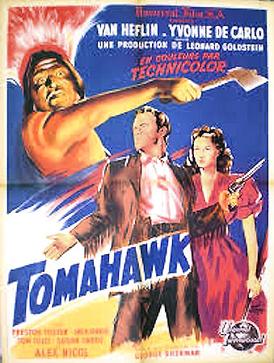Tomahawk (film)
1951 film From Wikipedia, the free encyclopedia
Tomahawk is a 1951 American Western film directed by George Sherman and starring Van Heflin and Yvonne De Carlo. The film is loosely based on events that took place in Wyoming in 1866 to 1868 around Fort Phil Kearny on the Bozeman Trail such as the Fetterman Fight and Wagon Box Fight. In the UK, the film was released as The Battle of Powder River.[3]
| Tomahawk | |
|---|---|
 Theatrical Poster | |
| Directed by | George Sherman |
| Screenplay by | Silvia Richards Maurice Geraghty |
| Based on | story by Daniel Jarrett |
| Produced by | Leonard Goldstein |
| Starring | Van Heflin Yvonne De Carlo |
| Cinematography | Charles P. Boyle |
| Edited by | Danny B. Landres |
| Music by | Hans J. Salter |
| Color process | Technicolor |
Production company | Universal Pictures |
| Distributed by | Universal Pictures |
Release date |
|
Running time | 82 minutes |
| Country | United States |
| Language | English |
| Budget | $750,000[1] |
| Box office | $2 million (US rentals)[2] |
It is one of the first films to empathise with the views of the Native Americans.
Plot
Summarize
Perspective
The story has two main threads: the white fur traders, and their relatively friendly relationship with the Sioux; and the US Cavalry who have a very distanced relationship with the Sioux. The traders and scouts are led by Jim Bridger who has the Indian name of "Tomahawk".
A small travelling show run by Julie Madden gets an escort cross-country to a fort from Lt Dancy. En route Dancy kills a young unarmed Sioux boy without provocation, for being near his horses. He tells his corporal to explain the night-time shot as him killing a fox. In retaliation on the following day, half a dozen mounted Sioux ambush the travelling show hitting Julie's elderly companion Dan with an arrow in the chest. They take the injured man to the fort but the doctor refuses to operate. Julie persuades Jim Bridger to operate and Bridger saves his life. Jim asks Julie to look after Monahseetah his female Cheyenne travelling companion, the daughter of Chief Black Kettle.
The Sioux approach the fort in small groups and pick off one sentry at a time then ride off. Julie has taken a horse out without permission and they chase her. Jim calls them off, but one still chases her. Jim pulls him from his horse and they fight. It is Red Cloud's favourite son and he is killed. When they get back to the fort they can hear the Sioux war drums.
Bridger discovers that Dancy killed his Cheyenne wife, Monahseetah's sister, after Dancy leads a suicidal attack on a group of Sioux where he is the sole survivor.
The Sioux attack the fort in waves but the newly arrived breech-loading rifles defeat them.
Cast
- Van Heflin as Jim Bridger
- Yvonne De Carlo as Julie Madden
- Alex Nicol as 1st. Lt. Rob Dancy
- Preston Foster as Col. Carrington
- Rock Hudson as Cpl. Burt Hanna
- Arthur Space as Capt. William J. Fetterman
- Russ Conway as Maj. Horton (as Russell Conway)
- Stuart Randall as Sgt. Newell
- Jack Oakie as Sol Beckworth (based on James Beckwourth)
- Tom Tully as Dan Castello [4]
- John War Eagle as Red Cloud
- Susan Cabot as Monahseetah
- Ann Doran as Mrs. Carrington
Production
The film was based on a story by Daniel Jarrett. Film rights were bought by Universal in 1947; they assigned Leonard Goldstein to produce and George Sherman to direct.[5][6] In August 1948 Universal announced the film would be one of their Technicolor productions for the following year, along with Calamity Jane and Sam Bass, Sierra, Streets of Cairo, Bloomer Girl and Bagdad.[7]
In May 1949 Stephen McNally was announced for the lead and Edna Anhalt was going to write the script.[8] McNally dropped out and was replaced by Van Heflin in March 1950 and Anhalt is not credited on the final film.[9] In April Yvonne De Carlo was cast opposite Heflin.[10] De Carlo liked that her part was more of a straight dramatic role.[11]
Shooting began in May 1950. The film was shot partly on location in South Dakota.[12]
Reception
The Los Angeles Times called it a "well made, exciting movie."[13]
In June 1952 Van Heflin and George Sherman were reported as working on a followup to the movie.[14]
References
External links
Wikiwand - on
Seamless Wikipedia browsing. On steroids.
